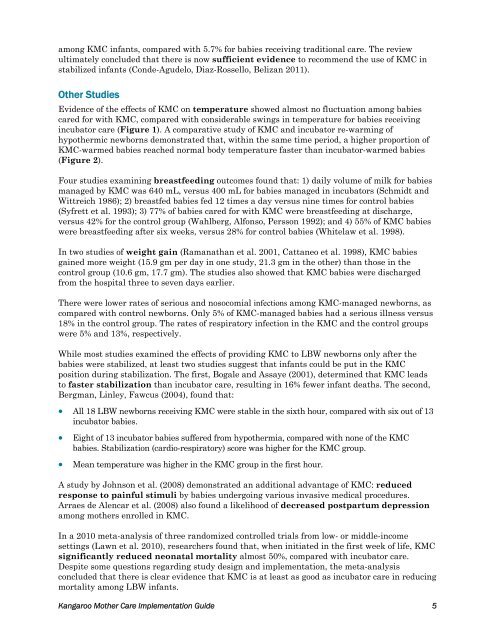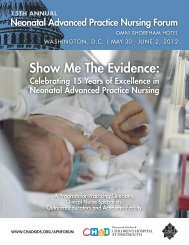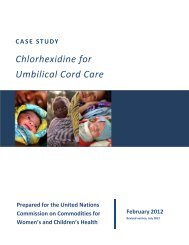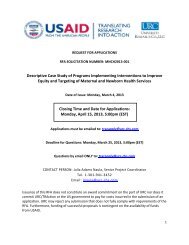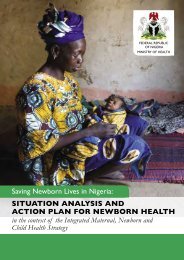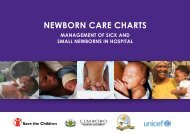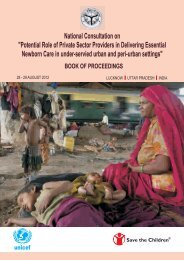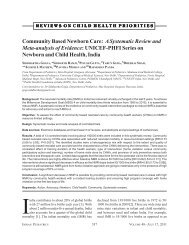Kangaroo Mother Care - MCHIP
Kangaroo Mother Care - MCHIP
Kangaroo Mother Care - MCHIP
Create successful ePaper yourself
Turn your PDF publications into a flip-book with our unique Google optimized e-Paper software.
among KMC infants, compared with 5.7% for babies receiving traditional care. The review<br />
ultimately concluded that there is now sufficient evidence to recommend the use of KMC in<br />
stabilized infants (Conde-Agudelo, Diaz-Rossello, Belizan 2011).<br />
Other Studies<br />
Evidence of the effects of KMC on temperature showed almost no fluctuation among babies<br />
cared for with KMC, compared with considerable swings in temperature for babies receiving<br />
incubator care (Figure 1). A comparative study of KMC and incubator re-warming of<br />
hypothermic newborns demonstrated that, within the same time period, a higher proportion of<br />
KMC-warmed babies reached normal body temperature faster than incubator-warmed babies<br />
(Figure 2).<br />
Four studies examining breastfeeding outcomes found that: 1) daily volume of milk for babies<br />
managed by KMC was 640 mL, versus 400 mL for babies managed in incubators (Schmidt and<br />
Wittreich 1986); 2) breastfed babies fed 12 times a day versus nine times for control babies<br />
(Syfrett et al. 1993); 3) 77% of babies cared for with KMC were breastfeeding at discharge,<br />
versus 42% for the control group (Wahlberg, Alfonso, Persson 1992); and 4) 55% of KMC babies<br />
were breastfeeding after six weeks, versus 28% for control babies (Whitelaw et al. 1998).<br />
In two studies of weight gain (Ramanathan et al. 2001, Cattaneo et al. 1998), KMC babies<br />
gained more weight (15.9 gm per day in one study, 21.3 gm in the other) than those in the<br />
control group (10.6 gm, 17.7 gm). The studies also showed that KMC babies were discharged<br />
from the hospital three to seven days earlier.<br />
There were lower rates of serious and nosocomial infections among KMC-managed newborns, as<br />
compared with control newborns. Only 5% of KMC-managed babies had a serious illness versus<br />
18% in the control group. The rates of respiratory infection in the KMC and the control groups<br />
were 5% and 13%, respectively.<br />
While most studies examined the effects of providing KMC to LBW newborns only after the<br />
babies were stabilized, at least two studies suggest that infants could be put in the KMC<br />
position during stabilization. The first, Bogale and Assaye (2001), determined that KMC leads<br />
to faster stabilization than incubator care, resulting in 16% fewer infant deaths. The second,<br />
Bergman, Linley, Fawcus (2004), found that:<br />
All 18 LBW newborns receiving KMC were stable in the sixth hour, compared with six out of 13<br />
incubator babies.<br />
<br />
<br />
Eight of 13 incubator babies suffered from hypothermia, compared with none of the KMC<br />
babies. Stabilization (cardio-respiratory) score was higher for the KMC group.<br />
Mean temperature was higher in the KMC group in the first hour.<br />
A study by Johnson et al. (2008) demonstrated an additional advantage of KMC: reduced<br />
response to painful stimuli by babies undergoing various invasive medical procedures.<br />
Arraes de Alencar et al. (2008) also found a likelihood of decreased postpartum depression<br />
among mothers enrolled in KMC.<br />
In a 2010 meta-analysis of three randomized controlled trials from low- or middle-income<br />
settings (Lawn et al. 2010), researchers found that, when initiated in the first week of life, KMC<br />
significantly reduced neonatal mortality almost 50%, compared with incubator care.<br />
Despite some questions regarding study design and implementation, the meta-analysis<br />
concluded that there is clear evidence that KMC is at least as good as incubator care in reducing<br />
mortality among LBW infants.<br />
<strong>Kangaroo</strong> <strong>Mother</strong> <strong>Care</strong> Implementation Guide 5


